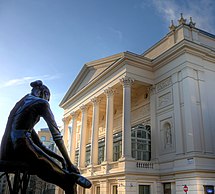Olga Preobrajenska was appointed prima ballerina of the Mariinsky Theatre in 1900. She spent 25 years with that company where she created many roles. Important though she was as a dancer she was even more influential as a teacher first in St Petersburg and later at the Salle Wacker near the Place de Clichy in Paris.
I was lucky enough to step inside the Salle Wacker on my first trip to Paris in September 1969 less than 7 years after that great dancer and teacher had died. My guide was one of her former students, Pamela Tipton (now Mrs. Carl Newton) who was then a graduate student at St. Andrews. Pamela, who is an American, had come to Europe when she was a little girl to study ballet.
I asked Pamela whether she could write something about Preobrajenska and this is what she sent me:
"Haven’t forgotten about your Olga P. request….don’t really know what to say except that she was a tiny and fierce little lady who believed in physical punishment and commanded the utmost respect from her students. I was 9 years old and terrified of her. I grew to love her and when she died, mother and I attended a benefit and somewhere I have one of her linens that we purchased. There was a gentleman at the studio who acted as her manager…he appeared to be slavishly devoted to her. As a child I did not know what their relationship was other than he also collected money for the dance lessons. I remember the time that Maria Tallchief came to the studio. She was beautiful. Many famous dancers came to her for instruction."
Tallchief was the first native American ballerina, the wife of George Ballanchine and one of his greatest dancers. Preobrajenska's other students included Margot Fonteyn, Maurice Béjart and many other stars.
Nick Wallace-Smith has uploaded some clips of Preobrajenska to YouTube, one of the her walking through the streets of Paris and another of her teaching at the very time Pamela was her pupil.
Happy Easter everybody!






.jpg/800px-Huddersfield_Railway_Station_(RLH).jpg)
